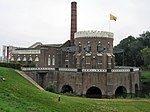Floriade 2002

The 2002 Floriade international horticultural exposition took place from April 6 to October 20, 2002, in Haarlemmermeer, Netherlands, with a theme of Contribution of Horticulture in the quality of life in the 21st century. Recognised by the Bureau International des Expositions (BIE), the festival covered 65 hectares and had 30 participating countries.Across the Floriade site is the Geniedijk, part of the Defence Line of Amsterdam, while the "Lake Side" was located in the Haarlemmermeer Woods. From the artificial mountain, visitors had a substantial view of the area. The Zuidtangent was opened around the same time as the Floriade, with temporary additional stops opened along the north and south entrances to the festival. The north stop is still occasionally used during events and festivals held on the site of the Floriade. The 2002 Floriade was also the site of the Spike and Suzy album, The Bright Floriade.
Excerpt from the Wikipedia article Floriade 2002 (License: CC BY-SA 3.0, Authors, Images).Floriade 2002
Drie Merenweg, Haarlemmermeer
Geographical coordinates (GPS) Address Nearby Places Show on map
Geographical coordinates (GPS)
| Latitude | Longitude |
|---|---|
| N 52.3358 ° | E 4.6675 ° |
Address
Big Spotters Hill
Drie Merenweg
2131 LZ Haarlemmermeer
North Holland, Netherlands
Open on Google Maps









